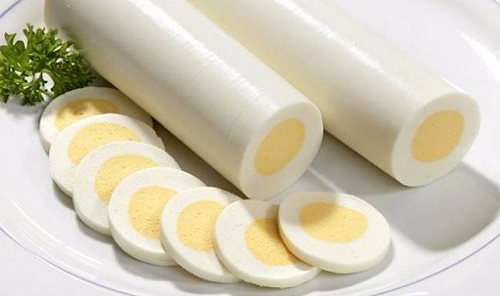Long Eggs
Long eggs are either: a) eggs laid by specially bred long chickens; or b) a highly engineered food product created in the 1970s to satisfy the food service industry's desire to have egg slices with a consistent ratio of white and yolk.
You can choose what you want to believe.

The video below shows how long eggs might be engineered. It's in German, but even if you don't speak that it's easy to understand what's going on.
You can choose what you want to believe.

source: shemazing.net
The video below shows how long eggs might be engineered. It's in German, but even if you don't speak that it's easy to understand what's going on.
Comments
In the 1980s Time Magazine had these featured in a brief bit. It was headlined "Lord what foods these morsels be?"
Posted by crc on 10/04/21 at 10:44 AM
It's not surprising that an industrial method of distributing eggs in such a fashion was developed. Reminds me of the method that is used to supply eggs to institutional kitchens by use of freeze-dried eggs. Just add water and heat!
Posted by KDP on 10/04/21 at 02:47 PM
These are produced by cooking the egg in a tube...
https://trendingposts.net/trending-food/curious-about-how-long-eggs-are-made/
https://trendingposts.net/trending-food/curious-about-how-long-eggs-are-made/
Posted by Teri on 10/04/21 at 11:30 PM
Oops! Got ahead of myself. You already knew that! I guess the "yolks" on me...
Posted by Teri on 10/04/21 at 11:34 PM
There are three major ways to produce them (or there was, it's quite possible one or two fell out of favor in the intervening years).
The video shows a batch process. It results in bars with straight ends.
Another way cooks the yolks in a mold. A plastic casing, much like a sausage casing, is closed at one end, half-filled with raw white, the firm yolk is inserted (making the white rise around it), the open end is crimped, and the whole thing is boiled to set the white. These have rounded ends, which means a little waste (unless chopped for chef's salads). The benefit is much less handling, much less space has to be kept sterile.
The way I thought was neat pumped the yolk through a heated tube which cooked it; the output was into a larger tube where white was pumped in around it, and it all came out as a cooked extrusion. One company which did it this way offered lengths up to twelve feet as special orders. I had it on good authority (a boozy night out with the assistant production superintendent) it was the mother of all nightmares to keep running, and they rarely got more than an hour at a time before having to tear it all down and restart. If the viscosity and temperature of either ingredient wasn't within an incredibly narrow margin, it'd come out gooey, in chunks, or resembling synthetic rubber. But when it worked, it was a dream.
The video shows a batch process. It results in bars with straight ends.
Another way cooks the yolks in a mold. A plastic casing, much like a sausage casing, is closed at one end, half-filled with raw white, the firm yolk is inserted (making the white rise around it), the open end is crimped, and the whole thing is boiled to set the white. These have rounded ends, which means a little waste (unless chopped for chef's salads). The benefit is much less handling, much less space has to be kept sterile.
The way I thought was neat pumped the yolk through a heated tube which cooked it; the output was into a larger tube where white was pumped in around it, and it all came out as a cooked extrusion. One company which did it this way offered lengths up to twelve feet as special orders. I had it on good authority (a boozy night out with the assistant production superintendent) it was the mother of all nightmares to keep running, and they rarely got more than an hour at a time before having to tear it all down and restart. If the viscosity and temperature of either ingredient wasn't within an incredibly narrow margin, it'd come out gooey, in chunks, or resembling synthetic rubber. But when it worked, it was a dream.
Posted by Phideaux on 10/04/21 at 11:58 PM
Commenting is not available in this channel entry.



Category: Food | Eggs